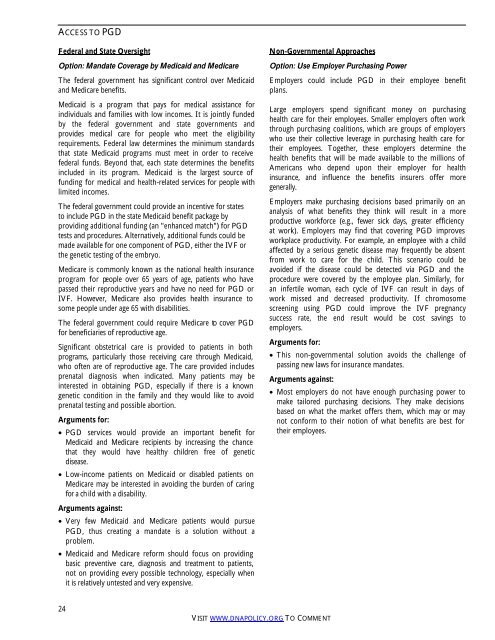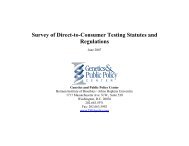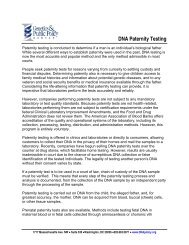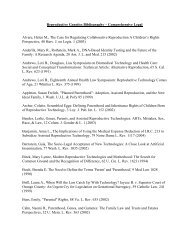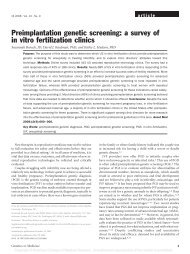Preimplantation Genetic Diagnosis - Genetics & Public Policy Center
Preimplantation Genetic Diagnosis - Genetics & Public Policy Center
Preimplantation Genetic Diagnosis - Genetics & Public Policy Center
Create successful ePaper yourself
Turn your PDF publications into a flip-book with our unique Google optimized e-Paper software.
ACCESS TO PGD<br />
Federal and State Oversight<br />
Option: Mandate Coverage by Medicaid and Medicare<br />
The federal government has significant control over Medicaid<br />
and Medicare benefits.<br />
Medicaid is a program that pays for medical assistance for<br />
individuals and families with low incomes. It is jointly funded<br />
by the federal government and state governments and<br />
provides medical care for people who meet the eligibility<br />
requirements. Federal law determines the minimum standards<br />
that state Medicaid programs must meet in order to receive<br />
federal funds. Beyond that, each state determines the benefits<br />
included in its program. Medicaid is the largest source of<br />
funding for medical and health-related services for people with<br />
limited incomes.<br />
The federal government could provide an incentive for states<br />
to include PGD in the state Medicaid benefit package by<br />
providing additional funding (an "enhanced match") for PGD<br />
tests and procedures. Alternatively, additional funds could be<br />
made available for one component of PGD, either the IVF or<br />
the genetic testing of the embryo.<br />
Medicare is commonly known as the national health insurance<br />
program for people over 65 years of age, patients who have<br />
passed their reproductive years and have no need for PGD or<br />
IVF. However, Medicare also provides health insurance to<br />
some people under age 65 with disabilities.<br />
The federal government could require Medicare to cover PGD<br />
for beneficiaries of reproductive age.<br />
Significant obstetrical care is provided to patients in both<br />
programs, particularly those receiving care through Medicaid,<br />
who often are of reproductive age. The care provided includes<br />
prenatal diagnosis when indicated. Many patients may be<br />
interested in obtaining PGD, especially if there is a known<br />
genetic condition in the family and they would like to avoid<br />
prenatal testing and possible abortion.<br />
Arguments for:<br />
• PGD services would provide an important benefit for<br />
Medicaid and Medicare recipients by increasing the chance<br />
that they would have healthy children free of genetic<br />
disease.<br />
• Low-income patients on Medicaid or disabled patients on<br />
Medicare may be interested in avoiding the burden of caring<br />
for a ch ild with a disability.<br />
Arguments against:<br />
• Very few Medicaid and Medicare patients would pursue<br />
PGD, thus creating a mandate is a solution without a<br />
problem.<br />
• Medicaid and Medicare reform should focus on providing<br />
basic preventive care, diagnosis and treatment to patients,<br />
not on providing every possible technology, especially when<br />
it is relatively untested and very expensive.<br />
Non-Governmental Approaches<br />
Option: Use Employer Purchasing Power<br />
Employers could include PGD in their employee benefit<br />
plans.<br />
Large employers spend significant money on purchasing<br />
health care for their employees. Smaller employers often work<br />
through purchasing coalitions, which are groups of employers<br />
who use their collective leverage in purchasing health care for<br />
their employees. Together, these employers determine the<br />
health benefits that will be made available to the millions of<br />
Americans who depend upon their employer for health<br />
insurance, and influence the benefits insurers offer more<br />
generally.<br />
Employers make purchasing decisions based primarily on an<br />
analysis of what benefits they think will result in a more<br />
productive workforce (e.g., fewer sick days, greater efficiency<br />
at work). Employers may find that covering PGD improves<br />
workplace productivity. For example, an employee with a child<br />
affected by a serious genetic disease may frequently be absent<br />
from work to care for the child. This scenario could be<br />
avoided if the disease could be detected via PGD and the<br />
procedure were covered by the employee plan. Similarly, for<br />
an infertile woman, each cycle of IVF can result in days of<br />
work missed and decreased productivity. If chromosome<br />
screening using PGD could improve the IVF pregnancy<br />
success rate, the end result would be cost savings to<br />
employers.<br />
Arguments for:<br />
• This non-governmental solution avoids the challenge of<br />
passing new laws for insurance mandates.<br />
Arguments against:<br />
• Most employers do not have enough purchasing power to<br />
make tailored purchasing decisions. They make decisions<br />
based on what the market offers them, which may or may<br />
not conform to their notion of what benefits are best for<br />
their employees.<br />
24<br />
VISIT WWW.DNAPOLICY.ORG TO COMMENT


